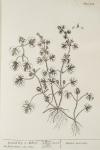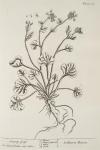

 225. Ground Ivy or Alehoof. Hedera terrestris.
225. Ground Ivy or Alehoof. Hedera terrestris.
1. The Stalks grow about eight Inches long, the Leaves are a grass Green, and the Flowers blue.
2. It grows by Hedges and Banks, flowring in April.
3. This Plant is esteem'd a very good Pectoral, being much used for Coughs, Shortness of Breath and other Disorders of the Lungs; for which a Tea made of the Leaves & a Syrup of the Juice is very beneficial. It is this Plant that they make the Gill Ale with, being accounted antiscorbutic and apperative, and good to provoke Urine & cleanse ye Ureters. Some Authors commend it steeped in
Brandy as of Great Service against the Collic. The Officinal Preparation is, the Syrup of ye Juice.
4. Greek, Κιανος χερδαισ Latin, Chamaecissus Spanish, Eda. Italian, Hedera terrestris. French, Lierre de la Terre. German Gundelreben. Dutch, Hondsdraf.

 226. The Cowslip or Paigle. Paralysis.
226. The Cowslip or Paigle. Paralysis.
Also see #052. Primrose - #226. Cowslip
1. The Stalks grow about six Inches high, the Leaves are a grass greena above and whitish underneath, and the Flowers
yellow.
2. It grows in moist Meadows and Marshes, flowring in April.
3. The Flowers are accounted cordial, and beneficial to the nervous Sistem, good against the Epilepsy, Palsy, Apoplexy & Pains in ye Head; Some say they are anodyne & good to procure sleep for which Purpose they make Tea of them. The Leaves are used in warming, strengthening Ointments, particularly the Unguent Nervinum. Officinal Preparations are, The Simple Water, The Syrup, and the Conserve.
4. Greek, . Latin, Primula veris major. Spanish, .
Italian, Fiore di Primavera. French, Primvere. German, Schlusselblumen. Dutch, Sleutelblom.

 227. Scurvy-Grass. Cochlearia Batava.
227. Scurvy-Grass. Cochlearia Batava.
Also see #218. Sea Scurvy-Grass - #227. Scurvy-Grass
1. The Stalks grow to be eight or nine Inches high, the Leaves are a grass Green, and the Flowers white.
2. It grows wild in the North of England by the Sea Side, but is very much cultivated in Gardens, and flowers in April.
3. This Plant abounds with fine volatile Parts, and therefore ye Herb infused or the Juice express'd, is more prevalent than a Decoction, the volatile Parts flying away in the Boiling, and is accounted a Specific Remedy against the Scurvy, Cleansing and purifying the Juices of the Body from the bad Effects of that Distemper, and clearing the Skin from Scabs, Pimples & foul Eruptions. Officinal
Preparations are, The Simple Water, The Spirit, and a Conserve.
4. Greek, .
Latin, Cochlearia Batava rotundifolia hortensis. Spanish, . Italian, . French, . Germán, Loffelcraut Dutch. Lepelbladen.

 228. Wake Robin or Cuckow pint. Arum.
228. Wake Robin or Cuckow pint. Arum.
1. The Stalks grow more than a Foot & an half high, the Leaves are a deep green, the Flowers purple and the Fruit a yellowish Red.
2. It grows in Hedges and dry Ditches, and flowers in May.
3. The Roots dryed & powdered are accounted good for a Cachexy, the Scurvy & Asthma; and the Quantity of a Drachm of ye Roots of Spotted Sort dryed is commended as an excellent Antipestilential & Leaves beat to a Cataplasm is good for Plague Sores. Matthiolus says a Poultice of ye Roots beat to mash & mix'd with Cow Dung, eases the Pains of the Gout.
4. Greek, Αρον. Latin, Arum maculatum Maculis nigris. Spanish. Yaro. Italian, Gigaro. French, Vit de Chien. German, Deutscher Imber. Dutch, Kalfsoot.

